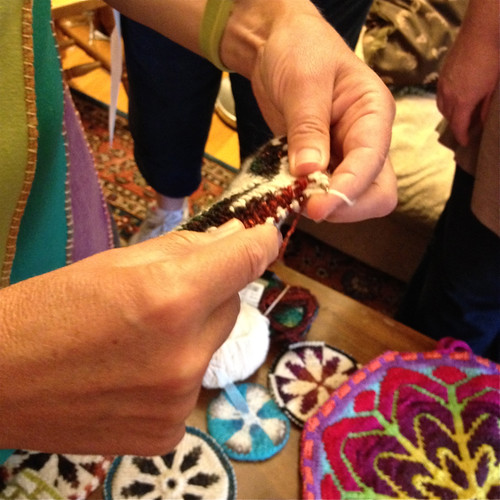
Hats are a perfect project for practicing colour-work. They can be knitted in the round, which is almost compulsory for colour-work. Then, they're just the right size to see if a fair isle pattern works well, but they're not so big that it's a major disaster if the colours or the motif mix don't work too well. I'd bought some 'sticky' fingering weight yarns in a mixture of colours during my visit to the USA - some Harrisville Designs Shetland and some Elemental Affects Shetland Fingering, so I was able to begin by playing around with possible colour combinations. In her classes Mary Jane had given excellent advice on combining and balancing light and dark colours in fair isle knitting, but I found the advice unexpectedly difficult to implement. One of the things I've always taken for granted in my knitting is a capacity to choose and combine colours, so I was unprepared for the amount of experimentation needed to find satisfactory combinations. One thing I think I learned at this stage is that you can never have too many different coloured yarns for fair isle knitting as quite minimal variations in hue can make a significant difference.
I began with the Shwook hat - a pattern from the admired Shetland knitter, Hazel Tindall.


The colours for this hat worked well, but on reflection I thought I had played a bit too safe, and so began another hat. This time I used the basic pattern for the smallest size of the Shwook hat but decorated it with two of the motifs from Mary Jane Mucklestone's '200 Fair Isle Motifs: A Knitter's Directory'. I used one of my favourite colour combinations - yellow and blue. My fair isle pattern designing skills are not yet sufficiently developed to invent a pattern for the crown of the hat, so I've repeated Hazel Tindall's design.


I tried Kyukker, another of Hazel Tindall's hat patterns because I liked its busyness, and was also attracted by the way that a deceptively floral motif had been devised from the squared-off grid that's the starting point for all fair isle. This time the colours didn't work quite so well as the yellow is too bright for the more subtle mauve and blues of most of the hat. I hope I'm learning a bit more about colour combining with each attempt.


By this stage I was feeling limited by the limited colour palette of my initial yarn purchases and so ordered more yarn, including the lovely rosey colour that was the basis for my next hat. This time I used the idea of Brooklyn Tweed's Turn a Square hat, adapted the pattern for fingering weight yarn and then combined some more of the traditional fair isle motifs from Mary Jane's wonderful book.


I think I had some vague memory of a Kaffe Fasset hat that combined stripes and florals (or maybe I've invented that recollection) and so striped the crown after completing the fair isle body of the hat. I'm not sure the combination has quite worked, but I think there is a good idea in there somewhere.
Now my problem is what to do with all these hats. My grand-daughter, whom I persuaded to model a couple of them (reluctantly) says they're 'too prickly'. Hmmm. I've offered them to my daughter as last-minute gifts, but she's said, most reasonably, that you can't give someone a warm hat in the heat of a Sydney summer. Maybe I'll just put them away till cooler weather comes and then think again.













































